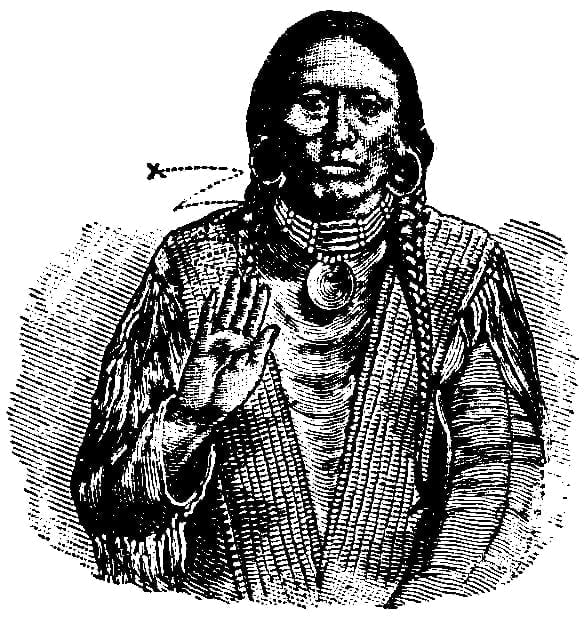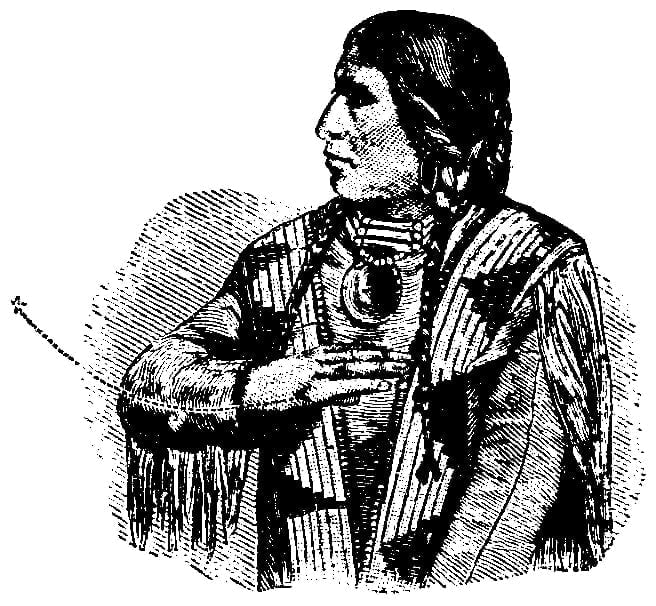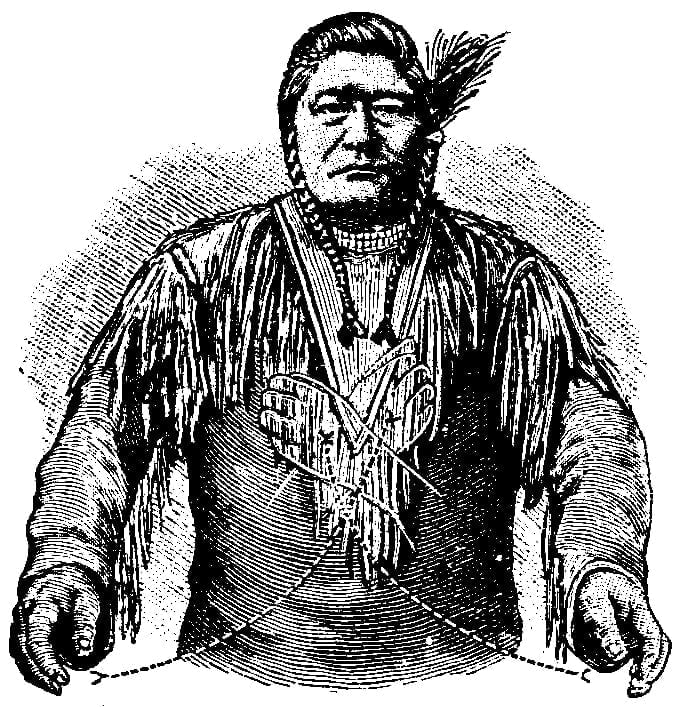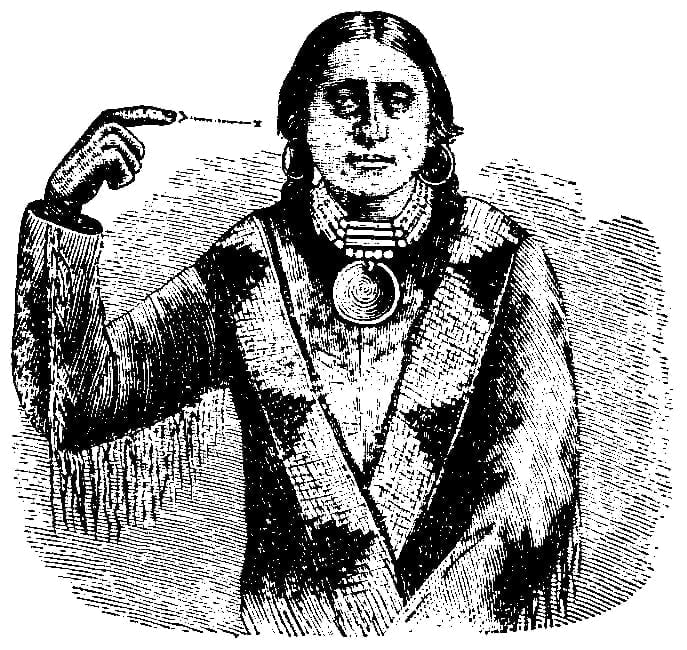The following conversation took place at Washington in April, 1880, between Tendoy, chief of the Shoshoni and Banak Indians of Idaho, and Huerito, one of the Apache chiefs from New Mexico, in the presence of Dr. W.J. Hoffman. Neither of these Indians spoke any language known to the other, or had ever met or heard of one another before that occasion:
Huerito. – Who are you?
Place the flat and extended right hand, palm forward, about twelve inches in front of and as high as the shoulder, then shake the hand from side to side as it is moved forward and upward – question, who are you? Fig. 304.

Tendoy. – Shoshoni chief.
Place the closed right hand near the right hip leaving the index only extended, palm down; then pass the hand toward the front and left, rotating it from side to side – Shoshoni, Fig. 305; then place the closed hand, with the index extended and pointing upward, near the right cheek, pass it upward as high as the head, then turn it forward and downward toward the ground, terminating with the movement a little below the initial point – chief. Fig. 306.


Huerito. – How old are you?
Clinch both hands and cross the forearms before the breast with a trembling motion – cold winter, year, Fig. 307; then elevate the left hand as high as the neck and about twelve or fifteen inches before it, palm toward the face, with fingers extended and pointing upward; then, with the index, turn down one finger after another slowly, beginning at the little finger, until three or four are folded against the palm, and look inquiringly at the person addressed – how many? See Fig. 302.

Tendoy. – Fifty-six.
Close and extend the fingers and thumbs of both hands, with the palms forward, five times – fifty; then extend the fingers and thumb of the left hand, close the right, and place the extended thumb alongside of and near the left thumb – six. Fig. 308.

Huerito. – Very well. Are there any buffalo in your country?
Place the flat right hand, pointing to the left, with the palm down, against the breast-bone; then move it forward and slightly to the right and in an upward curve; make the gesture rather slow and nearly to arm’s length (otherwise, i.e., if made hastily and but a short distance, it would only mean good) – very good, Fig. 309; place both closed hands to their respective sides of the head, palms toward the hair, leaving the forefingers curved - buffalo, see Fig. 298, p. 477; then reach out the fist to arm’s length toward the west, and throw it forcibly toward the ground for a distance of about six inches, edge downward – country, away to the west; then point the curved index rather quickly and carelessly toward the person addressed – your.

Tendoy. – Yes; many black buffalo.
Pass the closed right hand, with the index partly flexed, to a position about eight inches before the right collar-bone, and, as the hand reaches that elevation, quickly close the index - yes; then make the same sign as in the preceding question for buffalo; touch the hair on the right side of the head with the palms of the extended fingers of the right hand black; spread the curved fingers and thumbs of both hands, place them before either thigh, pointing downward; then draw them toward one another and upward as high as the stomach, so that the fingers will point toward one another, or may be interlaced – many. Fig. 310.

Tendoy. – Did you hear anything from the Secretary? If so, tell me.
Close the right hand, leaving the index and thumb widely separated, pass it by the ear from the back of the ear downward and toward the chin, palm toward the head – hear, see Fig. 316, p. 492; point to the individual addressed – you; close the hand again, leaving the index and thumb separated as in the sign for hear and placing the palmar surface of the finger horizontally across the forehead, pointing to the left, allow the thumb to rest against the right temple; then draw the index across the forehead from left to right, leaving the thumb touching the head – white man; then place the closed hand, with elevated index, before the right side of the neck or in front of the top of the shoulder; pass the index, pointing upward, as high as the top of the head; turn it forward and downward as far as the breast – chief; pass the extended index, pointing up ward and forward, forward from the mouth twice - talk; then open and flatten the hand, palm up, outer edge toward the face, place it about fifteen inches in front of the chin, and draw it horizontally inward until the hand nearly touches the neck – tell me.
Huerito. – He told me that in four days I would go to my country.
Close the right hand, leaving the index curved; place it about six inches from the ear and move it in toward the external meatus - told me, hear, I heard, Fig. 311; with the right hand still closed, form a circle with the index and thumb by allowing their tips to touch; pass the hand from east to west at arm’s length – day; place the left hand before the breast, the fingers extended, and the thumb resting against the palm, back forward, and, with the index, turn down one finger after another, beginning at the little finger – four; touch the breast with the tips of the finger and thumb of the left hand collected to a point – I; drop the hand a short distance and move it forward to arm’s length and slightly upward until it points above the horizon – go to*; then as the arm is extended, throw the fist edgewise toward the ground - my country.

Tendoy. – In two days I go to my country just as you go to yours. I go to mine where there is a great deal of snow, and we shall see each other no more.
Place the flat hands horizontally, about two feet apart, move them quickly in an upward curve toward one another until the right lies across the left – night, Fig. 312, repeat this sign – two nights (literally two sleeps hence); point toward the individual addressed with the right hand – you; and in a continuous movement pass the hand to the right, i.e., toward the south, nearly to arm’s length – go; then throw the fist edgewise toward the ground at that distance – your country; then touch the breast with the tips of the fingers of the left handI; move the hand off slowly toward the left, i.e., toward the north to arm’s length – go to*; and throw the clinched hand toward the ground – my country; then hold both hands toward the left as high as the head, palms down, with fingers and thumbs pendent and separated; move them toward the ground two or three times – rain, Fig. 313; then place the flat hands horizontally to the left of the body about two feet from the ground – deep; (literally, deep rain) snow – and raise them until about three feet from the ground - very deep – much; place the hands before the body about twelve inches apart, palms down, with forefingers only extended and pointing toward one another; push them toward and from one another several times – see each other, Fig. 314; then hold the flat right hand in front of the breast, pointing forward, palm to the left, and throw it over on its back toward the right – not, no more.



Explanatory Note. – Where the asterisks appear in the above dialogue the preposition to is included in the gesture. After touching the breast for I, the slow movement forward signifies going to, and country is signified by locating it at arm’s length toward the west, to the left of the gesturer, as the stopping-place, also possession by the clinched fist being directed toward the ground. It is the same as for my or mine, though made before the body in the latter signs. The direction of Tendoy’s hands, first to the south and afterwards to the north, was understood not as pointing to the exact locality of the two parts of the country, but to the difference in their respective climates.
